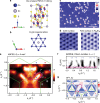Tunable anomalous Hall conductivity through volume-wise magnetic competition in a topological kagome magnet
- PMID: 31992705
- PMCID: PMC6987130
- DOI: 10.1038/s41467-020-14325-w
Tunable anomalous Hall conductivity through volume-wise magnetic competition in a topological kagome magnet
Abstract
Magnetic topological phases of quantum matter are an emerging frontier in physics and material science. Along these lines, several kagome magnets have appeared as the most promising platforms. Here, we explore magnetic correlations in the kagome magnet Co3Sn2S2. Using muon spin-rotation, we present evidence for competing magnetic orders in the kagome lattice of this compound. Our results show that while the sample exhibits an out-of-plane ferromagnetic ground state, an in-plane antiferromagnetic state appears at temperatures above 90 K, eventually attaining a volume fraction of 80% around 170 K, before reaching a non-magnetic state. Strikingly, the reduction of the anomalous Hall conductivity (AHC) above 90 K linearly follows the disappearance of the volume fraction of the ferromagnetic state. We further show that the competition of these magnetic phases is tunable through applying either an external magnetic field or hydrostatic pressure. Our results taken together suggest the thermal and quantum tuning of Berry curvature induced AHC via external tuning of magnetic order.
Conflict of interest statement
The authors declare no competing interests.
Figures





References
-
- Yin J-X, et al. Negative flatband magnetism in a spin-orbit coupled kagome magnet. Nat. Phys. 2019;15:443–448. doi: 10.1038/s41567-019-0426-7. - DOI

